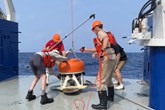NASA applies space technology to produce algae-based fuel
NASA has created plastic osmotic containers that grow algae, which produce oil. The benefits of this new method are that it does not compete with agriculture for land, freshwater, or fertiliser, which means that this method of making biofuels does not have to compete with land used for food purposes. Another advantage is the fact that the method cleans wastewater during the biofuels creation process, which means it can help remediate dead zones. Combining these benefits with algae products such as biofuel, fertiliser, and animal feed, makes this new technology cost-competitive with land-based production methods for algae biofuels.
The process
The NASA process is relatively simple. It starts with algae being placed in sewage-filled plastic bags. These bags are called OMEGA which stands for "offshore membrane enclosures for growing algae". The OMEGA bags are semi permeable membranes that NASA developed to recycle astronauts' wastewater on long space missions. In this case, the membranes let freshwater exit but prevent saltwater from entering.
Three goals
- It is possible to produce sustainable quantities of biofuels that can replace the use of fossil fuels without competing for resources and land needed for food production.
- These valued products are produced, while at the same time they help cleanse municipal wastewater and remediate dead zones such as those in the Baltic Sea.
- It is possible to produce products, clean the oceans, and at the same time remove the greenhouse gas, CO2, from the atmosphere.
Read the article online at: https://www.oilfieldtechnology.com/drilling-and-production/30112009/nasa_oil_algae/
You might also like
A new standard for observing deep ocean currents
Uncrewed technology collaboration in US Gulf of Mexico, from Sonardyne and SeaTrac Systems.


